Warning: even more pic heavy than usual :sweat:
UPDATE DEC 10, 2010: Eagletac has recently revised the M3C4 SST-50 to a new version with a deeper and smooth reflector, for more throw. Please see my specific review of that light for more info.


Eagletac has updated its "Military" line of high-output lights (i.e.. M2C4/M2XC4) in a revised build known as the M3C4. A wide variety of emitter types are available in the M3C4 format, including all of those used previously in the M2-series light. But they have also added a few new options, two of which are reviewed here – the 3xR5 XP-G version, and the SST-50 version of the M3C4
Manufacturer Specifications: Common Specs for M3C4 Series

Packaging is the same for all members of the M3C4 series – with stickers on the outside identifying the specific emitter and tint of the light inside.
Packaging is similar to the earlier M2-series, but with one extra – an included bezel-replacing diffuser. Also included with the light are extra o-rings, wrist lanyard, warranty card and manual, primary battery holders, clicky-switch battery carrier, and a good quality nylon case that fits the light well.



From left to right: AW Protected 18650, M3C4 SST-50, M3C4 3xR5 XP-G, M2XC4 3xR2 XR-E, M2C4 SSC P7, Sunway M40C.
All weights below are without batteries installed, but include the regular carrier.
M3C4 SST-50: Length: 158mm, Width: 61mm (bezel), Weight: 334.7g
M3C4 3xR5 XP-G: Length: 158mm, Width: 61mm (bezel), Weight: 374.1g
M2C4 SSC P7: Length: 163mm, Width: 61mm (bezel), Weight: 351.7g
M2XC4 3xR2 XR-E: Length 160mm, Width: 61mm (bezel), Weight: 395.8g
As you can see, overall weight and length has dropped slightly from the earlier M2 series lights. Bezel diameter has not changed.

The overall build looks similar to the M2-series, but there a few noticeable upgrades.
The head is now a single-piece unit, apparently to help with water-resistance and length. However, the bezel is still removable, and you can still access the reflector/lens by removing the outer ring below the bezel (there is a retaining ring holding the lens in place - not shown). But there's no reason to open the head unless you need to replace a broken lens. Eagletac cautions against trying to "clean" the inside of the lens, as there is an anti-reflective coating you are likely to damage.
As with the M2-series, the light features anodized screw threads, allowing for head lock-out. Lube was a bit overly generous on my sample.
The contact springs in the head are covered (as before) - although the contact surfaces not as gold-colored as they were on the M2-series lights.
The lights apparently come in two types of type III anodizing – dark gray as shown here (similar to my Sunway lights), or black. Regardless, the plastic control ring and tailcap cover are made of black plastic. Anodizing quality is top-notch on my samples. There is plenty of ridge detail to help with grip, plus some medium-strength knurling on the head. Lettering is sharp and clear, bright-white against the dark background.


Unfortunately, the top of the battery handle still has four Phillips-head screws holding it to the battery tube portion. I would prefer that this were a single piece of aluminum – I recommend you periodically check these screws to make sure they don't loosen up and compromise water-resistance of the battery handle.
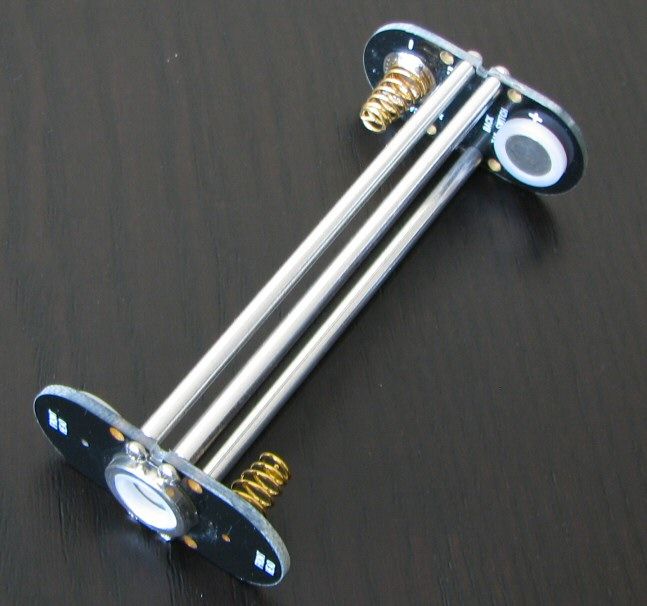
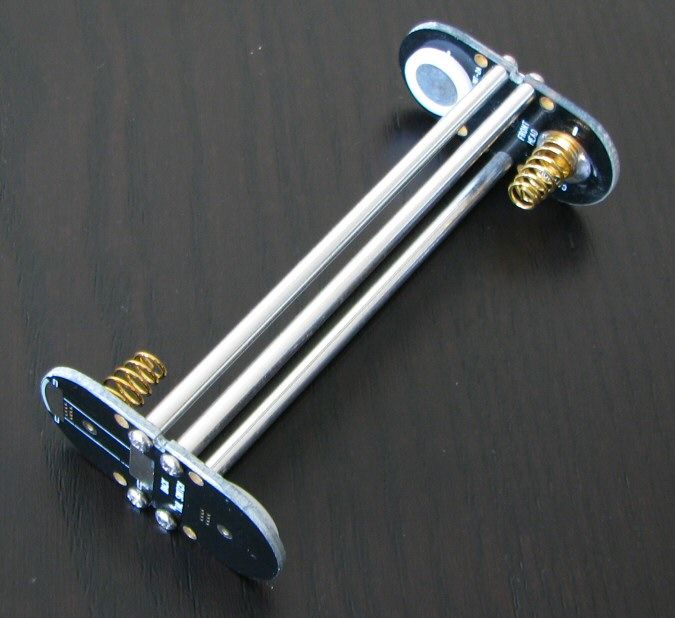
The battery carrier has been updated slightly as well. Note that flat-top high-capacity cells may not work in the carrier, as the plastic contact ring around the positive terminal is slightly raised. You can use CR123A cells with or without the included plastic holder.
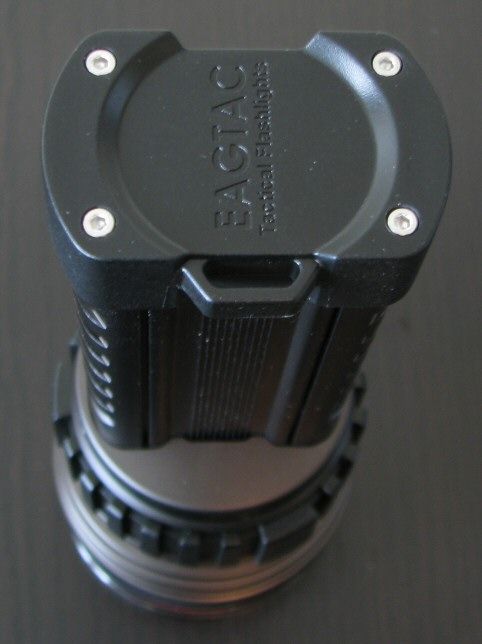

The tailcap region seems to be more securely fashioned on these M3 series lights. The cover is a tight fit now, with a well-formed o-ring underneath. Note also the use of hex screws here. Included is a hex Allen key if you need to tighten the screws or want to swap the battery carrier for the clicky version. But be advised that I was unable to loosen one of the screws on mine with the key – it seemed to be just a touch too small (i.e. kept spinning inside the screw head). A 7/64" hex screwdriver did the trick for me on that one.
UPDATE: Scroll down this thread to see that at least one CPF user reports a problem with a stripped hex screw when trying to swap the tailcap. Note that Eagletac's warranty specifically does NOT cover damages from stripped mounting screws!

Eagletac also provided me with a sample of their own branded primary CR123A batteries. I haven't tested these yet, but will add them to my CR123A battery round-up when I get the chance.

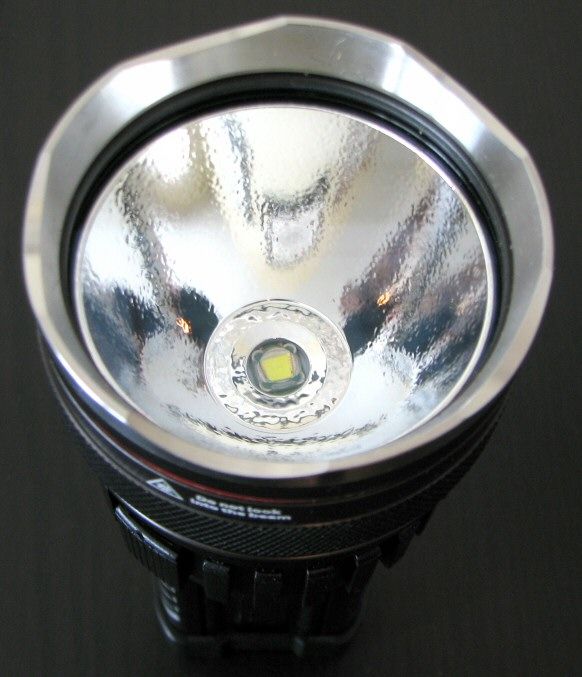


The emitters appear to be well centered on my samples. Like before, the 3xCree option has overlapping reflector wells.
Eagletac also sent their optional YRGB colored filter kit (yellow, red, green, blue). Like the included diffuser, these screw on as a replacement for the stainless steel bezel ring.
Without a flash:

With a flash:

The filters seem to be of good quality, with all but the red one showing colored reflections upon angled lighting. Scroll down for beamshots.
Beamshots
Sorry for the quality of the white wall beamshots – I've recently moved, and haven't had a chance to set up a proper beamshot closet yet. What you are looking at below is primed drywall that hasn't been painted yet – so there are still some imperfections.
Here are some up-close shots comparing to the new M3C4s to my M2XC4 3xR2 XR-E and M2C4 SSC P7. All lights are on 2xAW protected 18650, ~1m from the wall:




As expected the M3C4 3xR5 XP-G still shows a "daisy-pattern" spillbeam (common on multi-emitter lights with overlapping wells). Also as expected, throw is also reduced somewhat from the M2C4 3xR2 XR-E (although you would only notice at a significant difference - at up to ~5m, they are really pretty equivalent).




The M3C4 SST-50 has a similar beam pattern to the M2C4 SSC P7. Both lights have a wider (but dimmer) spillbeam compared to the multi-emitter options. The hotspot of the M3C4 SST-50 is probably the most defined of all the M2- and M3-series lights in my possession.
Not shown, but up-close (i.e. <1m) there is a noticeable void in the centre of the M3C4 SST-50's beam. Of course, who would be using this light at <1m …
I've recently added some additional lights to my 100-Yard Outdoor Beamshot Round-up, including the lights in this review. Check out that round-up thread for more details on the testing method, plus higher quality JPEG images of all lights. For now, here are a couple of animated GIFs of relevant M2- and M3-series comparisons:
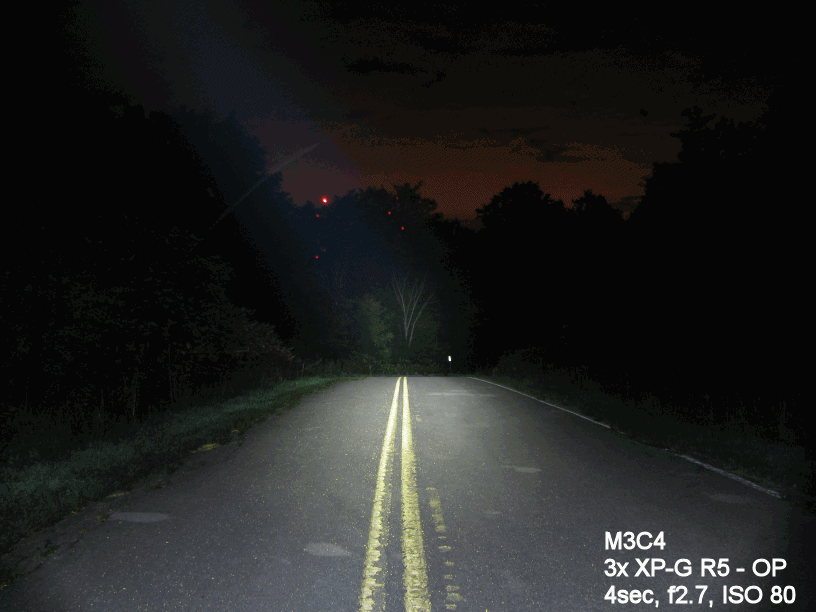


To better show what the optional YRGB filter kit and standard diffuser look like, here are comparison pics of the M3C4 3xR5 XP-G, all taken at ~1m with my camera's standard Sunlight white balance correction (~5200K).
M3C4 3xR5 XP-G

Diffuser

Yellow Filter

Red Filter

Green Filter

Blue Filter

Not surprisingly, the Yellow and Blue filters let the most light through (i.e. Cool white emitters are relatively deficient in Green and Red wavelengths). The Yellow filter is not as green as it may appear above – that's an artifact of the defined color balance on the camera.
User Interface
The control ring functions similar to the earlier M2-series lights, but again with a few upgrades.
With the standard battery carrier, there is always a standby current if the head is fully tightened against the body.
To turn the light on, turn the control ring clockwise (with the light pointed away from you). The light will proceed out of Standby and through Moonlight, Lo, Med, Hi and Turbo in sequence. The spacing between modes is only approximate, but I didn't find either of my samples to be too far out kilter.
The difference from the M2 series is that strobe is now relegated to a "hidden" mode. To access, rapidly switch from Turbo to Standby and back to Turbo again. This will replace Turbo with Strobe. Do this switch again to advance to Beacon, and again for SOS (note the manual has Beacon/SOS order reversed). Do it once more to return to standard output modes with Turbo.
Alternatively, you can loosen the head (or click off the optional clicky switch) to break the connection to the battery carrier and fully shut off the light. This also restores the standard output modes upon re-activation.
Note that the light moves through the output levels in a gradual fade into each level over ~1sec or so as you turn the ring (i.e. you don't see a sharp jump in output).
With the forward clicky switch module installed, the light can be turned on in any mode by the switch (with the control ring controlling the output level as before). There is no standby current with the clicky switch in the off position.
Note that there is a ~1sec lag to activation when the clicky switch is soft-pressed or clicked on. There is also a Med output "pre-flash" if you activate the switch with the ring in the Moonlight or Lo mode state (i.e. the light comes in Med, and fades down to Lo/Moonlight).
Parasitic Standby Drain
The parasitic standby drain of the M2 series was always fairly high at ~720uA (reported by HKJ). For a pair of standard 2200mAh 18650 in series, that translates into just over 4 months before the batteries would be fully drained.
I measured my M3C4 samples and found 1130uA (3xR5 XP-G) and 1170uA (SST-50) on standby mode. That would translate into 81 and 78 days, respectively, before fully charged 2200mAh batteries would be completely drained.
I therefore recommend you store the lights with the head locked-out, or use the optional clicky switch battery carrier. There is no standby current with the switched clicked in the off position.
No PWM
As with the M2-series lights, there is no evidence of PWM on any mode. The lights appear to be fully current-controlled at all levels. :twothumbs
Strobe/SOS/Beacon

Strobe is a reasonably quick 7.9Hz.

Beacon is actually a slow strobe – 2Hz freq.
Testing Method: All my output numbers are relative for my home-made light box setup, a la Quickbeam's flashlight reviews method. You can directly compare all my relative output values from different reviews - i.e. an output value of "10" in one graph is the same as "10" in another. All runtimes are done under a cooling fan.
Throw/Output Summary Chart:
Note: All throw measures below were taken at 5m and extrapolated back to estimates at 1m. 1m actual measurements would give you highly misleading results, as the beams of thrower lights don't have time to converge by that distance.
Also, my throw numbers may be lower than some - I take all readings from the center of the hotspot. A number of emitters produce a brighter edge of the hotspot (i.e. a relatively dark center). However, since it is hard to reliably measure anything but the center, I stick with that for my measures.
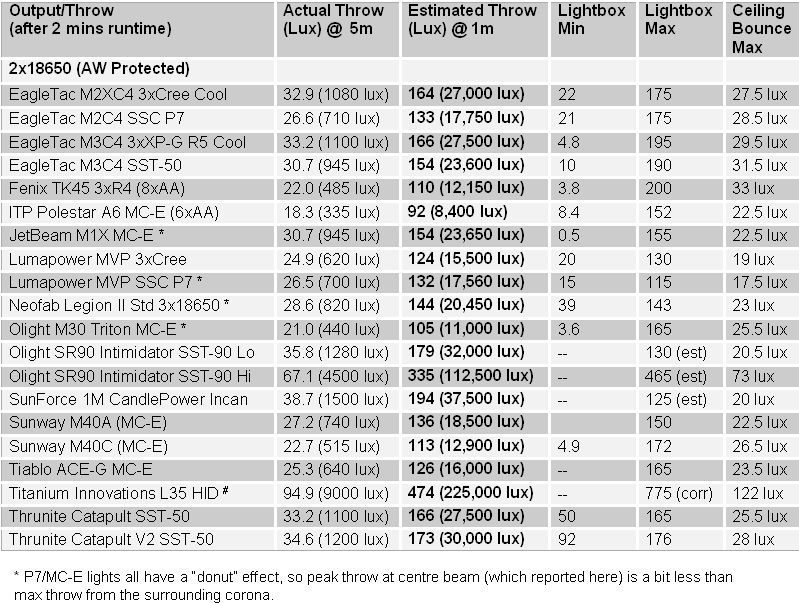
Note that the lowest output level ("Moonlight") is a bit variable for the M3C4 lights. While in keeping with the lowest possible Lo modes of other current-controlled lights, it is now as low as some of the PWM-based lights.
Output/Runtime Comparison
Note: Effective January 2010, all CR123A runtimes are now performed on Titanium Innovations batteries. You can compare the performance of these CR123A cells relative to the Duracell/Surefire cells used in my earlier reviews here. These new light results are marked by an "*" in the graph legend



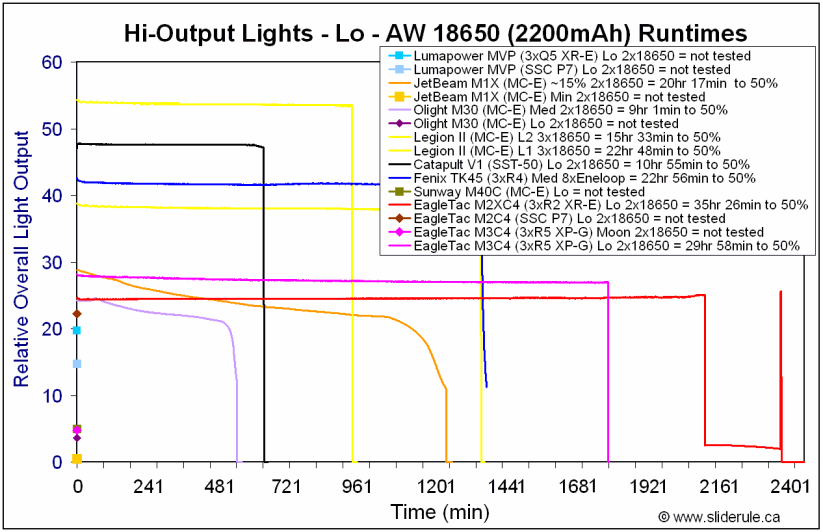

Basically, thanks to the newer emitters, max overall output of the new M3C4 lights reviewed here has increased somewhat. Overall runtime characteristics do not appear to have appreciably changed much.
Note that while my lightbox reports a higher output score for the 3xR5 XP-G version over the SST-50 version, my ceiling bounce gives the opposite result. :shrug: The very different beam profiles makes it hard to reliably ascribe a specific relative output.
Potential Issues
Although the build has a number of improvements, the handle is still composed of three separate pieces (tailcap, battery tube, front portion that screws into the head). Although each section has its own o-ring, you should keep an eye on all the screws to make sure they don't loosen up with time (and thus impair water-proofness).
Standby parasitic drain is still very high for the M3C4 series – enough to fully drain a pair of 2200mAh 18650s in less than 3 months. I recommend you store the lights with the head locked out (or with optional clicky battery carrier in the clicked off position).
The is a Med-level pre-flash when using the clicky switch with the control ring set to Moonlight or Lo. There is also a ~1sec delay in activation when using the clicky switch to turn on.
Flat-top 18650 cells may not work in the battery carrier, due to the raised plastic ring around the positive contact plate.
UPDATE: If you scroll down this thread, you will see at least one CPF user reports a problem with a stripped hex screw when trying to swap the tailcap. As mentioned previously, I had my own difficulties in removing one of the screws - there seems to be some variation in the size. Note that Eagletac's warranty specifically does NOT cover damages from stripped mounting screws!
Preliminary Observations
The M3-series lights have a nice set of incremental upgrades to original Eagletac M2-series.
I particularly like the addition of the two new emitter options reviewed here (SST-50 and 3x XP-G R5). Frankly, I'm a little surprised that Eagletac has kept so many emitter variants for the new M3C4 line (i.e I would have thought they'd drop some of the old M2-series ones). :thinking: But the option for relatively warm "Neutral White" for many of the emitter types is most welcome – I know a lot of members here prefer warmer tints.
Build is a uniform improvement over the old M2-series. :thumbsup: Although most of the changes are fairly minor individually, the net effect is significant. I particularly like the revised user interface (with strobe et al relegated to hidden modes) and the revised tailcap with hex screws (both the new standard flat and clicky-switch designs). The control ring also seems more consistent in its spacing than the earlier M2-series (although still not exactly equal in all modes).
The small reductions in weight and height are also appreciated. The lights still feels quite substantial, with significant heatsinking – something some the competitors in this class may lack. The lights now feature a lower Lo mode (although "Moonlight" may be overstating it ). Even minor touches like the fade-in and –out of levels seems kind of classy. And I like the new dark grey anodizing finish.
). Even minor touches like the fade-in and –out of levels seems kind of classy. And I like the new dark grey anodizing finish. 
That said, there are still a few things that haven't changed from the M2-series lights that I would like to see different. Chief among these are the relatively high parasitic standby drain (although you can easily lock-out the light). Also, I don't like the 3-piece body handle design requiring 8 screws and two o-rings to hold the handle together. :sigh:
As for the emitters, both the SST-50 and 3xR5 XP-G options give a lot of light – slightly more than their earlier counterparts, the SSC P7 and 3xR2 XR-E. They also have smoother beam profiles (e.g. no dark center void on the SST-50). Of course, if you prefer the earlier emitters (e.g. smaller hotspot on the 3xXR-E), they are still available in the M3C4 build.
At the end of the day, is there enough to make you want to "upgrade" from an existing M2-series build? That depends on what matters to you – but in most cases, I would suspect not. But if you are in the market for a new light, there is certainly no reason to go for the M2-series lights instead. You can get everything the M2-series offered – and more – in the upgraded M3C4 build.
One last point - Eagletac has to be among the most generous in terms of bundled extras with these lights. I personally quite like the bundled diffuser, now standard on the M3C4 series. :thumbsup:
UPDATE DEC 10, 2010: Eagletac has recently revised the M3C4 SST-50 to a new version with a deeper and smooth reflector, for more throw. Please see my specific review of that light for more info.
------
The M3C4 lights were provided for review by Eagletac.
UPDATE DEC 10, 2010: Eagletac has recently revised the M3C4 SST-50 to a new version with a deeper and smooth reflector, for more throw. Please see my specific review of that light for more info.


Eagletac has updated its "Military" line of high-output lights (i.e.. M2C4/M2XC4) in a revised build known as the M3C4. A wide variety of emitter types are available in the M3C4 format, including all of those used previously in the M2-series light. But they have also added a few new options, two of which are reviewed here – the 3xR5 XP-G version, and the SST-50 version of the M3C4
Manufacturer Specifications: Common Specs for M3C4 Series
- New one-piece flashlight head design (from the top of the knurling area to the battery contact point behind the head). This allows optimal LED heatsink capability and operational reliability. The flashlight head is not sealed and user can gain access to the inside of the lens and reflector.
- New durable hard anodization coating in HA (type III) finish (40 μm in thickness and 350-380 HV in hardness).
- New Reflector design in L.O.P. finish
- The tail-stand tail-cap receives a new durable protective coating. The package also come with a para-cord lanyard with darken holding clip that fits in the tail-cap lanyard hole. The controller ring also receives the new durable protective coating.
- The Flashlight head and the body are o-rings and square-rings sealed for operating in harsh and wet environments. Reverse battery polarity protection has been implemented on the battery tray for each battery channel. The water-proof tail-cap now uses stainless steel 304 mounting screws with hex heads.
- Included accessories:
- CNC machined 304 Stainless steel bezel
- Included diffuser filter. YRGB filter kit (yellow for fog and rain) is optional.
- Paracord lanyard with darken pocket clips and split ring
- M series nylon holster
- Luminus SST-50 W65S WJ LED (maximum output, single LED)
- O.T.F. lumen output: 16/56/172/376/800
- LED lumen output: 20/70/215/470/1000
- Battery: two 18650 rechargeable or four CR123A primary
- Runtime: 1.5/3.5/8/28/100+ hours
- Estimated MSRP: ~$170
- Triple CREE XP-G Cool White R5 LED (maximum output, three individual LEDs)
- O.T.F. lumen output: 15/55/172/593/800
- LED lumen output: 18/70/215/475/1000
- Battery: two 18650 rechargeable or four CR123A primary
- Runtime: 1.5/3.5/8/28/100+ hours
- Estimated MSRP: ~$160

Packaging is the same for all members of the M3C4 series – with stickers on the outside identifying the specific emitter and tint of the light inside.
Packaging is similar to the earlier M2-series, but with one extra – an included bezel-replacing diffuser. Also included with the light are extra o-rings, wrist lanyard, warranty card and manual, primary battery holders, clicky-switch battery carrier, and a good quality nylon case that fits the light well.



From left to right: AW Protected 18650, M3C4 SST-50, M3C4 3xR5 XP-G, M2XC4 3xR2 XR-E, M2C4 SSC P7, Sunway M40C.
All weights below are without batteries installed, but include the regular carrier.
M3C4 SST-50: Length: 158mm, Width: 61mm (bezel), Weight: 334.7g
M3C4 3xR5 XP-G: Length: 158mm, Width: 61mm (bezel), Weight: 374.1g
M2C4 SSC P7: Length: 163mm, Width: 61mm (bezel), Weight: 351.7g
M2XC4 3xR2 XR-E: Length 160mm, Width: 61mm (bezel), Weight: 395.8g
As you can see, overall weight and length has dropped slightly from the earlier M2 series lights. Bezel diameter has not changed.

The overall build looks similar to the M2-series, but there a few noticeable upgrades.
The head is now a single-piece unit, apparently to help with water-resistance and length. However, the bezel is still removable, and you can still access the reflector/lens by removing the outer ring below the bezel (there is a retaining ring holding the lens in place - not shown). But there's no reason to open the head unless you need to replace a broken lens. Eagletac cautions against trying to "clean" the inside of the lens, as there is an anti-reflective coating you are likely to damage.
As with the M2-series, the light features anodized screw threads, allowing for head lock-out. Lube was a bit overly generous on my sample.
The contact springs in the head are covered (as before) - although the contact surfaces not as gold-colored as they were on the M2-series lights.
The lights apparently come in two types of type III anodizing – dark gray as shown here (similar to my Sunway lights), or black. Regardless, the plastic control ring and tailcap cover are made of black plastic. Anodizing quality is top-notch on my samples. There is plenty of ridge detail to help with grip, plus some medium-strength knurling on the head. Lettering is sharp and clear, bright-white against the dark background.


Unfortunately, the top of the battery handle still has four Phillips-head screws holding it to the battery tube portion. I would prefer that this were a single piece of aluminum – I recommend you periodically check these screws to make sure they don't loosen up and compromise water-resistance of the battery handle.


The battery carrier has been updated slightly as well. Note that flat-top high-capacity cells may not work in the carrier, as the plastic contact ring around the positive terminal is slightly raised. You can use CR123A cells with or without the included plastic holder.


The tailcap region seems to be more securely fashioned on these M3 series lights. The cover is a tight fit now, with a well-formed o-ring underneath. Note also the use of hex screws here. Included is a hex Allen key if you need to tighten the screws or want to swap the battery carrier for the clicky version. But be advised that I was unable to loosen one of the screws on mine with the key – it seemed to be just a touch too small (i.e. kept spinning inside the screw head). A 7/64" hex screwdriver did the trick for me on that one.
UPDATE: Scroll down this thread to see that at least one CPF user reports a problem with a stripped hex screw when trying to swap the tailcap. Note that Eagletac's warranty specifically does NOT cover damages from stripped mounting screws!

Eagletac also provided me with a sample of their own branded primary CR123A batteries. I haven't tested these yet, but will add them to my CR123A battery round-up when I get the chance.




The emitters appear to be well centered on my samples. Like before, the 3xCree option has overlapping reflector wells.
Eagletac also sent their optional YRGB colored filter kit (yellow, red, green, blue). Like the included diffuser, these screw on as a replacement for the stainless steel bezel ring.
Without a flash:

With a flash:

The filters seem to be of good quality, with all but the red one showing colored reflections upon angled lighting. Scroll down for beamshots.
Beamshots
Sorry for the quality of the white wall beamshots – I've recently moved, and haven't had a chance to set up a proper beamshot closet yet. What you are looking at below is primed drywall that hasn't been painted yet – so there are still some imperfections.
Here are some up-close shots comparing to the new M3C4s to my M2XC4 3xR2 XR-E and M2C4 SSC P7. All lights are on 2xAW protected 18650, ~1m from the wall:




As expected the M3C4 3xR5 XP-G still shows a "daisy-pattern" spillbeam (common on multi-emitter lights with overlapping wells). Also as expected, throw is also reduced somewhat from the M2C4 3xR2 XR-E (although you would only notice at a significant difference - at up to ~5m, they are really pretty equivalent).




The M3C4 SST-50 has a similar beam pattern to the M2C4 SSC P7. Both lights have a wider (but dimmer) spillbeam compared to the multi-emitter options. The hotspot of the M3C4 SST-50 is probably the most defined of all the M2- and M3-series lights in my possession.
Not shown, but up-close (i.e. <1m) there is a noticeable void in the centre of the M3C4 SST-50's beam. Of course, who would be using this light at <1m …
I've recently added some additional lights to my 100-Yard Outdoor Beamshot Round-up, including the lights in this review. Check out that round-up thread for more details on the testing method, plus higher quality JPEG images of all lights. For now, here are a couple of animated GIFs of relevant M2- and M3-series comparisons:



To better show what the optional YRGB filter kit and standard diffuser look like, here are comparison pics of the M3C4 3xR5 XP-G, all taken at ~1m with my camera's standard Sunlight white balance correction (~5200K).
M3C4 3xR5 XP-G

Diffuser

Yellow Filter

Red Filter

Green Filter

Blue Filter

Not surprisingly, the Yellow and Blue filters let the most light through (i.e. Cool white emitters are relatively deficient in Green and Red wavelengths). The Yellow filter is not as green as it may appear above – that's an artifact of the defined color balance on the camera.
User Interface
The control ring functions similar to the earlier M2-series lights, but again with a few upgrades.
With the standard battery carrier, there is always a standby current if the head is fully tightened against the body.
To turn the light on, turn the control ring clockwise (with the light pointed away from you). The light will proceed out of Standby and through Moonlight, Lo, Med, Hi and Turbo in sequence. The spacing between modes is only approximate, but I didn't find either of my samples to be too far out kilter.
The difference from the M2 series is that strobe is now relegated to a "hidden" mode. To access, rapidly switch from Turbo to Standby and back to Turbo again. This will replace Turbo with Strobe. Do this switch again to advance to Beacon, and again for SOS (note the manual has Beacon/SOS order reversed). Do it once more to return to standard output modes with Turbo.
Alternatively, you can loosen the head (or click off the optional clicky switch) to break the connection to the battery carrier and fully shut off the light. This also restores the standard output modes upon re-activation.
Note that the light moves through the output levels in a gradual fade into each level over ~1sec or so as you turn the ring (i.e. you don't see a sharp jump in output).
With the forward clicky switch module installed, the light can be turned on in any mode by the switch (with the control ring controlling the output level as before). There is no standby current with the clicky switch in the off position.
Note that there is a ~1sec lag to activation when the clicky switch is soft-pressed or clicked on. There is also a Med output "pre-flash" if you activate the switch with the ring in the Moonlight or Lo mode state (i.e. the light comes in Med, and fades down to Lo/Moonlight).
Parasitic Standby Drain
The parasitic standby drain of the M2 series was always fairly high at ~720uA (reported by HKJ). For a pair of standard 2200mAh 18650 in series, that translates into just over 4 months before the batteries would be fully drained.
I measured my M3C4 samples and found 1130uA (3xR5 XP-G) and 1170uA (SST-50) on standby mode. That would translate into 81 and 78 days, respectively, before fully charged 2200mAh batteries would be completely drained.

I therefore recommend you store the lights with the head locked-out, or use the optional clicky switch battery carrier. There is no standby current with the switched clicked in the off position.
No PWM
As with the M2-series lights, there is no evidence of PWM on any mode. The lights appear to be fully current-controlled at all levels. :twothumbs
Strobe/SOS/Beacon

Strobe is a reasonably quick 7.9Hz.
Beacon is actually a slow strobe – 2Hz freq.
Testing Method: All my output numbers are relative for my home-made light box setup, a la Quickbeam's flashlight reviews method. You can directly compare all my relative output values from different reviews - i.e. an output value of "10" in one graph is the same as "10" in another. All runtimes are done under a cooling fan.
Throw/Output Summary Chart:
Note: All throw measures below were taken at 5m and extrapolated back to estimates at 1m. 1m actual measurements would give you highly misleading results, as the beams of thrower lights don't have time to converge by that distance.
Also, my throw numbers may be lower than some - I take all readings from the center of the hotspot. A number of emitters produce a brighter edge of the hotspot (i.e. a relatively dark center). However, since it is hard to reliably measure anything but the center, I stick with that for my measures.

Note that the lowest output level ("Moonlight") is a bit variable for the M3C4 lights. While in keeping with the lowest possible Lo modes of other current-controlled lights, it is now as low as some of the PWM-based lights.
Output/Runtime Comparison
Note: Effective January 2010, all CR123A runtimes are now performed on Titanium Innovations batteries. You can compare the performance of these CR123A cells relative to the Duracell/Surefire cells used in my earlier reviews here. These new light results are marked by an "*" in the graph legend





Basically, thanks to the newer emitters, max overall output of the new M3C4 lights reviewed here has increased somewhat. Overall runtime characteristics do not appear to have appreciably changed much.
Note that while my lightbox reports a higher output score for the 3xR5 XP-G version over the SST-50 version, my ceiling bounce gives the opposite result. :shrug: The very different beam profiles makes it hard to reliably ascribe a specific relative output.
Potential Issues
Although the build has a number of improvements, the handle is still composed of three separate pieces (tailcap, battery tube, front portion that screws into the head). Although each section has its own o-ring, you should keep an eye on all the screws to make sure they don't loosen up with time (and thus impair water-proofness).
Standby parasitic drain is still very high for the M3C4 series – enough to fully drain a pair of 2200mAh 18650s in less than 3 months. I recommend you store the lights with the head locked out (or with optional clicky battery carrier in the clicked off position).
The is a Med-level pre-flash when using the clicky switch with the control ring set to Moonlight or Lo. There is also a ~1sec delay in activation when using the clicky switch to turn on.
Flat-top 18650 cells may not work in the battery carrier, due to the raised plastic ring around the positive contact plate.
UPDATE: If you scroll down this thread, you will see at least one CPF user reports a problem with a stripped hex screw when trying to swap the tailcap. As mentioned previously, I had my own difficulties in removing one of the screws - there seems to be some variation in the size. Note that Eagletac's warranty specifically does NOT cover damages from stripped mounting screws!
Preliminary Observations
The M3-series lights have a nice set of incremental upgrades to original Eagletac M2-series.
I particularly like the addition of the two new emitter options reviewed here (SST-50 and 3x XP-G R5). Frankly, I'm a little surprised that Eagletac has kept so many emitter variants for the new M3C4 line (i.e I would have thought they'd drop some of the old M2-series ones). :thinking: But the option for relatively warm "Neutral White" for many of the emitter types is most welcome – I know a lot of members here prefer warmer tints.
Build is a uniform improvement over the old M2-series. :thumbsup: Although most of the changes are fairly minor individually, the net effect is significant. I particularly like the revised user interface (with strobe et al relegated to hidden modes) and the revised tailcap with hex screws (both the new standard flat and clicky-switch designs). The control ring also seems more consistent in its spacing than the earlier M2-series (although still not exactly equal in all modes).
The small reductions in weight and height are also appreciated. The lights still feels quite substantial, with significant heatsinking – something some the competitors in this class may lack. The lights now feature a lower Lo mode (although "Moonlight" may be overstating it
That said, there are still a few things that haven't changed from the M2-series lights that I would like to see different. Chief among these are the relatively high parasitic standby drain (although you can easily lock-out the light). Also, I don't like the 3-piece body handle design requiring 8 screws and two o-rings to hold the handle together. :sigh:
As for the emitters, both the SST-50 and 3xR5 XP-G options give a lot of light – slightly more than their earlier counterparts, the SSC P7 and 3xR2 XR-E. They also have smoother beam profiles (e.g. no dark center void on the SST-50). Of course, if you prefer the earlier emitters (e.g. smaller hotspot on the 3xXR-E), they are still available in the M3C4 build.
At the end of the day, is there enough to make you want to "upgrade" from an existing M2-series build? That depends on what matters to you – but in most cases, I would suspect not. But if you are in the market for a new light, there is certainly no reason to go for the M2-series lights instead. You can get everything the M2-series offered – and more – in the upgraded M3C4 build.
One last point - Eagletac has to be among the most generous in terms of bundled extras with these lights. I personally quite like the bundled diffuser, now standard on the M3C4 series. :thumbsup:
UPDATE DEC 10, 2010: Eagletac has recently revised the M3C4 SST-50 to a new version with a deeper and smooth reflector, for more throw. Please see my specific review of that light for more info.
------
The M3C4 lights were provided for review by Eagletac.
Last edited:



